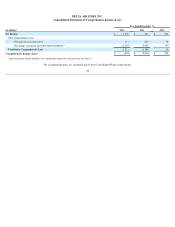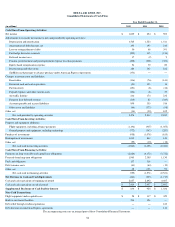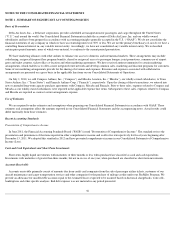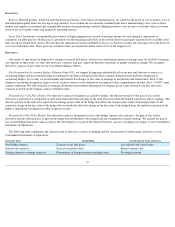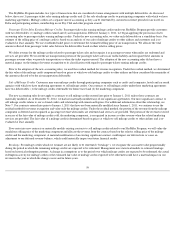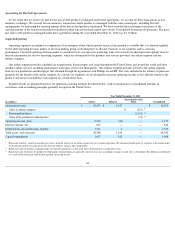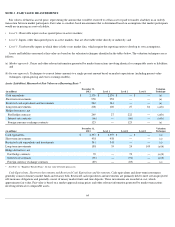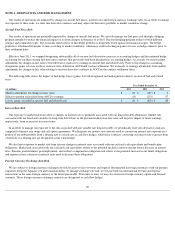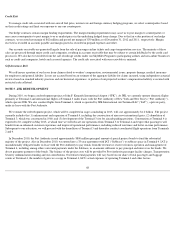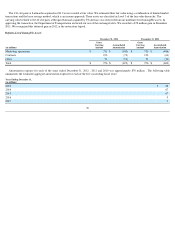Delta Airlines 2012 Annual Report Download - page 68
Download and view the complete annual report
Please find page 68 of the 2012 Delta Airlines annual report below. You can navigate through the pages in the report by either clicking on the pages listed below, or by using the keyword search tool below to find specific information within the annual report.
is the amount by which the aircraft's carrying amount exceeds its estimated fair value. We estimate aircraft fair values using published sources,
appraisals and bids received from third parties, as available.
Goodwill and Other Intangible Assets
We apply a fair value-based impairment test to the net book value of goodwill and indefinite-lived intangible assets on an annual basis (as of
October 1) and, if certain events or circumstances indicate that an impairment loss may have been incurred, on an interim basis. In July 2012, the
FASB issued "Testing Indefinite-Lived Intangible Assets for Impairment." The standard gives companies the option to perform a qualitative
assessment to determine whether it is more likely than not that an indefinite-lived intangible asset is impaired rather than calculating the fair value of
the indefinite-lived intangible asset. It is effective prospectively for annual and interim impairment tests performed for fiscal years beginning after
September 15, 2012, with early adoption permitted. We adopted this standard and have applied the provisions to our annual indefinite-lived
intangible asset impairment tests in the December 2012 quarter. The adoption of this standard did not have a material impact on our Consolidated
Financial Statements. In September 2011, the FASB issued "Testing Goodwill for Impairment." The standard revises the way in which entities test
goodwill for impairment. We adopted this standard and applied its provisions to our annual goodwill impairment test in the December 2011 quarter.
We value goodwill and identified intangible assets primarily using market capitalization and income approach valuation techniques. These
measurements include the following significant unobservable inputs: (1) our projected revenues, expenses and cash flows, (2) an estimated weighted
average cost of capital, (3) assumed discount rates depending on the asset and (4) a tax rate. These assumptions are consistent with those hypothetical
market participants would use. Since we are required to make estimates and assumptions when evaluating goodwill and indefinite-lived intangible
assets for impairment, the actual amounts may differ materially from these estimates.
Changes in certain events and circumstances could result in impairment. Factors which could cause impairment include, but are not limited to, (1)
negative trends in our market capitalization, (2) an increase in fuel prices, (3) declining passenger mile yields, (4) lower passenger demand as a result
of a weakened U.S. and global economy, (5) interruption to our operations due to an employee strike, terrorist attack, or other reasons and (6)
changes to the regulatory environment.
Goodwill. Our goodwill balance, which is related to the airline segment, was $9.8 billion at December 31, 2012 . In evaluating goodwill for
impairment, we estimate the fair value of our reporting unit by considering market capitalization and other factors if it is more likely than not that the
fair value of our reporting unit is less than its carrying value. If the reporting unit's fair value exceeds its carrying value, no further testing is required.
If, however, the reporting unit's carrying value exceeds its fair value, we then determine the amount of the impairment charge, if any. We recognize
an impairment charge if the carrying value of the reporting unit's goodwill exceeds its estimated fair value.
Identifiable Intangible Assets. Our identifiable intangible assets, which are related to the airline segment, had a net carrying amount of
$4.7 billion
at December 31, 2012 . Indefinite-lived assets are not amortized and consist primarily of routes, slots, the Delta tradename and assets related to
SkyTeam and collaborative arrangements. Definite-lived intangible assets consist primarily of marketing agreements and contracts and are amortized
on a straight-line basis or under the undiscounted cash flows method over the estimated economic life of the respective agreements and contracts.
Costs incurred to renew or extend the term of an intangible asset are expensed as incurred.
We assess our indefinite-lived assets under a qualitative or quantitative approach. We analyze market factors to determine if events and
circumstances have affected the fair value of the indefinite-lived intangible assets. If we determine that it is more likely than not that the asset value
may be impaired, we use the quantitative approach to assess the asset's fair value and the amount of the impairment. We perform the quantitative
impairment test for indefinite-lived intangible assets by comparing the asset's fair value to its carrying value. Fair value is estimated based on (1)
recent market transactions, where available, (2) a combination of limited market transactions and the lease savings method for certain airport slots
(which reflects potential lease savings from owning the slots rather than leasing them from another airline at market rates), (3) the royalty method for
the Delta tradename (which assumes hypothetical royalties generated from using our tradename) or (4) projected discounted future cash flows. We
recognize an impairment charge if the asset's carrying value exceeds its estimated fair value.
Income Taxes
We account for deferred income taxes under the liability method. We recognize deferred tax assets and liabilities based on the tax effects of
temporary differences between the financial statement and tax bases of assets and liabilities, as measured by current enacted tax rates. Deferred tax
assets and liabilities are recorded net as current and noncurrent deferred income taxes. A valuation allowance is recorded to reduce deferred tax assets
when necessary. For additional information about our income taxes, see Note 12 .
61



